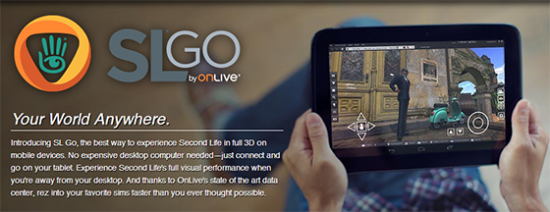Last week Linden Lab and the OnLive cloud gaming service debuted a new service aimed at delivering Second Life to almost any device capable of connecting to the internet. While still in beta and available for PCs, OSX and Android — iOS support is coming — I had an opportunity to play with SLGo and, from a technical standpoint, it truly is revolutionary.
What are Onlive & SLGo?
Most of you reading this are probably already familiar with the hybrid client/server model that functions as an interface between you and Second Life or your favorite MMORPG. Essentially, a user downloads a client — or a Second Life viewer — that acts as an interactive layer and display. For Second Life, the client allows you to download object and avatar rendering data for the regions you’re in, as well as, download and interact with various ancillary items like your inventory, private messages, maps and so forth.
However, most of this data — with the exception of cached objects — is stored in Linden Labs’ servers. To render your world, the client downloads the data uses your computer’s resources to process and display it on your screen. For those with more modest systems and internet connections, rendering and navigating a view might be a time consuming and often frustrating chore. Even with every object in a region cached, rendering each frame on high settings using a mid-range GPU while navigating the world can be a jittery experience to say the least.
OnLive – and, by extension, SLGo – and cloud gaming in general seeks to eliminate that frustration. At its core, cloud gaming — or “gaming as a service†(GaaS) as it’s also been called — is not unlike using YouTube. The difference is that a user interacts directly with what’s being streamed in the video. If you log into a game via the OnLive service, the entirety of the game is hosted, rendered and played on OnLive’s remote servers. You are simply seeing a live video feed. OnLive’s propriety thin client has only one job – display the video (and act as a marketplace and social hub). Any average computing device with a typical internet connection, from an older LAN-connected laptop to a WIFI-connected tablet, can stream the video in HD.
The end result, as I experienced with my five-year-old, dual-core Dell Inspiron laptop, is a stunning view of Second Life at 50 FPS with all settings set to Ultra.
Why this is a big deal…
While live video streaming has been around a relatively long time, being able to interact with that stream in real time is a whole new ball game.
Because the heavy lifting of rendering is offloaded to high end data centers, video capable devices (which includes most devices these days) now have the ability to provide an experience nearly identical to a high end, multi-thousand dollar system at a fraction of the price! At the time of this writing, a subscription to OnLive was about US$10 per month – which includes hundreds of popular games. Many of the games are a year old or less. SLGo is based on hourly usage and starts at US$3 per hour. A 10-hour block can be purchased for US$25.00. There is also a free 20 minute trial if you just want to try it out.
More pros than cons
If you’ve ever wanted to use Second Life (or any other game for that matter) with all your settings maxed out and with zero screen tearing (the term for that annoying effect you get when you spin your avatar and two halves of different frames appear on screen), then OnLive and SLGo is for you. And, if you want to have access to a ton of different games without paying for each one, the OnLive service is perfect.
Cloud gaming does have a few cons, though. The two most important technology issues are lag and dropped packets. Lag is the difference in time it takes for you to provide an input such as a mouse movement or keystroke and the time it takes for the remote system to calculate, render and stream the response to your screen. Depending on your connection, this can range from an unnoticeable 15 milliseconds to a noticeable but tolerable 60 milliseconds .
Dropped packets are when a piece of transmitted information is “lost†during the transfer. This can happen for a variety of reasons – corruption during transfer, a moment of excessive lag, and so on. This most often happens in a WiFi scenario where multiple users can create cause spikes and lulls in data transfer and atmospheric or environmental effects can degrade signals.
The other issue is cost. Currently, three dollars an hour is pretty expensive for something one can do for just the cost of one’s connection.
Reality and the future
During my real world — though not scientific — testing, the technical problems went from annoying but tolerably infrequent on a home WiFi connection to virtually non-existent using a wired LAN connection. Indeed, when plugged in, the streamed version’s graphics and performance were vastly superior.
All this said, the technology is evolving quickly. But for virtual worlds like Second Life and slow-paced strategy games, cloud gaming is already perfect. With the advent of high-bandwidth, low-latency and dual-spectrum AC wireless routers, you can expect the lag and dropped packets issues to be greatly improve. And, as more people join, costs should go down.
I highly recommend giving SLGo a try.
- SLGo puts virtual world in the cloud - March 11, 2014

